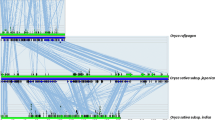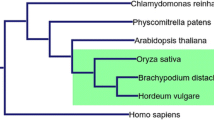Abstract
Lrk (Lr10 receptor-like kinase) and Tak (Triticum aestivum kinase) belong to the receptor-like kinase (RLK) supergene family in higher plants. Three Lrk/Tak gene regions spanning greater than 600 kb were identified via a genome-wide survey of barley gene-rich BAC clones. Two Lrk/Tak gene clusters are positioned on barley chromosome 3 (3H) and another is localized on chromosome 5 (1H), with each Lrk and Tak open reading frame physically positioned in a back-to-back orientation. Thirteen new Lrk/Tak-like fragments were cloned from the two clusters on 3H and the single cluster on 1H, respectively, and compared phylogenetically with other grass Lrk/Tak-like genes, including a 280-kb Lrk/Tak cluster on rice chromosome 1S. Physically clustered Lrk/Tak-like genes always form monophyletic groups; this suggests that the primary mechanism of expansion of the Lrk/Tak RLK super family was by tandem duplication, of which most members were duplicated after speciation of the Poaceae. Cultivar-dependent transcript accumulation of some Lrk/Tak family members on 3H, as revealed via Barley1 GeneChip microarray analysis, is consistent with the hypothesis of subfunctionalization of Lrk/Tak members following tandem duplication.






Similar content being viewed by others
References
Becraft PW, Stinard PS, McCarty DR (1996) CRINKLY4: A TNFR-like receptor kinase involved in maize epidermal differentiation. Science 273:1406–1409
Blanc G, Wolfe KH (2004) Functional divergence of duplicated genes formed by polyploidy during Arabidopsis evolution. Plant Cell 16:1679–1691 DOI 10.1105/tpc.021410
Bommert P, Lunde C, Nardmann J, Vollbrecht E, Running M, Jackson D, Hake S, Werr W (2005) Thick tassel dwarf1 encodes a putative maize ortholog of the Arabidopsis CLAVATA1 leucine-rich repeat receptor-like kinase. Development 132:1235–1245
Brueggeman R, Rostoks N, Kudrna D, Kilian A, Han F, Chen J, Druka A, Steffenson B, Kleinhofs A (2002) The barley stem rust-resistance gene Rpg1 is a novel disease-resistance gene with homology to receptor kinases. Proc Natl Acad Sci U S A 99:9328–9333
Caldo RA, Nettleton D, Wise RP (2004) Interaction-dependent gene expression in Mla-specified response to barley powdery mildew. Plant Cell 16:2514–2528
Clark SE, Running MP, Meyerowitz EM (1993) Clavata1, a regulator of meristem and flower development in Arabidopsis. Development 119:397–418
Feuillet C, Keller B (1999) High gene density is conserved at syntenic loci of small and large grass genomes. Proc Natl Acad Sci U S A 96:8265–8270
Feuillet C, Schachermayr G, Keller B (1997) Molecular cloning of a new receptor-like kinase gene encoded at the Lr10 disease resistance locus of wheat. Plant J 11:45–52
Feuillet C, Penger A, Gellner K, Mast A, Keller B (2001) Molecular evolution of receptor-like kinase genes in hexaploid wheat. Independent evolution of orthologs after polyploidization and mechanisms of local rearrangements at paralogous loci. Plant Physiol 125:1304–1313
Force A, Lynch M, Pickett FB, Amores A, Yan Y-l, Postlethwait J (1999) Preservation of duplicate genes by complementary, degenerative mutations. Genetics 151:1531–1545
Goff SA (2002) A draft sequence of the rice genome (Oryza sativa L. ssp. japonica). Science 296:92–100
Kellis M, Birren BW, Lander ES (2004) Proof and evolutionary analysis of ancient genome duplication in the yeast Saccharomyces cerevisiae. Nature 428:617–624
Kleinhofs A (2002) Integrating molecular and morphological/physiological marker maps. Barley Genet Newsl 32:152–159
Kleinhofs A (1993) A molecular, isozyme and morphological map of the barley (Hordeum vulgare) genome. Theor Appl Genet 86:705–712
Lespinet O, Wolf YI, Koonin EV, Aravind L (2002) The role of lineage-specific gene family expansion in the evolution of eukaryotes. Genome Res 12:1048–1059
Li J, Chory J (1997) A putative leucine-rich repeat receptor kinase involved in brassinosteroid signal transduction. Cell 90:929–938
Luo ZW, Potokina E, Druka A, Wise R, Waugh R, Kearsey MJ (2007) SFP genotyping from Affymetrix arrays is robust but largely detects cis-acting expression regulators. Genetics 176:789–800 DOI 10.1534/genetics.106.067843
Lynch M (2002) Genomics: gene duplication and evolution. Science 297:945–947
Maere S, De Bodt S, Raes J, Casneuf T, Van Montagu M, Kuiper M, Van de Peer Y (2005) Modeling gene and genome duplications in eukaryotes. Proc Natl Acad Sci U S A 102:5454–5459 DOI 10.1073/pnas.0501102102
Manly KF, Cudmore JRH, Meer JM (2001) Map manager QTX, cross-platform software for genetic mapping. Mamm Genome 12:930–932
Meyers BC, Kaushik S, Nandety RS (2005) Evolving disease resistance genes. Curr Opin Plant Biol 8:129–134
Moseman JG (1972) Isogenic barley lines for reaction to Erysiphe graminis f.sp. hordei. Crop Sci 12:681–682
Nirmala J, Brueggeman R, Maier C, Clay C, Rostoks N, Kannangara CG, von Wettstein D, Steffenson BJ, Kleinhofs A (2006) Subcellular localization and functions of the barley stem rust resistance receptor-like serine/threonine-specific protein kinase Rpg1. Proc Natl Acad Sci U S A 103:7518–7523 DOI 10.1073/pnas.0602379103
Potokina E, Druka A, Luo Z, Wise R, Waugh R, Kearsey M (2008) Gene expression quantitative trait locus analysis of 16000 barley genes reveals a complex pattern of genome-wide transcriptional regulation. Plant J 53:90–101 DOI 10.1111/j.1365-313X.2007.03315.x
Robinson DR, Wu YM, Lin SF (2000) The protein tyrosine kinase family of the human genome. Oncogene 19:5548–5557
Sasaki T (2002) The genome sequence and structure of rice chromosome 1. Nature 420:312–316
Schenk PM, Kazan K, Wilson I, Anderson JP, Richmond T, Somerville SC, Manners JM (2000) Coordinated plant defense responses in Arabidopsis revealed by microarray analysis. Proc Natl Acad Sci U S A 97:11655–11660
Shen L, Gong J, Caldo RA, Nettleton D, Cook D, Wise RP, Dickerson JA (2005) BarleyBase—an expression profiling database for plant genomics. Nucleic Acids Res 33:D614–618 DOI 10.1093/nar/gki123
Shiu S-H, Bleecker AB (2001) Receptor-like kinases from Arabidopsis form a monophyletic gene family related to animal receptor kinases. Proc Natl Acad Sci U S A 98:10763–10768
Shiu S-H, Karlowski WM, Pan R, Tzeng Y-H, Mayer KFX, Li W-H (2004) Comparative analysis of the receptor-like kinase family in Arabidopsis and rice. Plant Cell 16:1220–1234
Simillion C, Vandepoele K, Van Montagu MCE, Zabeau M, Van de Peer Y (2002) The hidden duplication past of Arabidopsis thaliana. Proc Natl Acad Sci U S A 99:13627–13632
Song W-Y (1995) A receptor kinase-like protein encoded by the rice disease resistance gene, Xa21. Science 270:1804–1806
Stein JC, Howlett B, Boyes DC, Nasrallah ME, Nasrallah JB (1991) Molecular cloning of a putative receptor kinase gene encoded at the self-incompatibility locus of Brassica oleracea. Proc Natl Acad Sci U S A 88:8816–8820
The Flybase Consortium (1999) The FlyBase database of the Drosophila Genome Projects and community literature. Nucleic Acids Res 27:85–88 DOI 10.1093/nar/27.1.85
Wei F, Wing RA, Wise RP (2002) Genome dynamics and evolution of the Mla (powdery mildew) resistance locus in barley. Plant Cell 14:1903–1917
Yu Y (2000) A bacterial artificial chromosome library for barley (Hordeum vulgare) and the identification of clones containing putative resistance genes. Theor Appl Genet 101:1093–1099
Zhou H (2007) Molecular analysis of three new receptor-like kinase genes from hexaploid wheat and evidence for their participation in the wheat hypersensitive response to stripe rust fungus infection. Plant J 52:420–434 DOI 10.1111/j.1365-313X.2007.03246.x
Acknowledgments
The authors thank Matt Moscou for assistance with the GeneChip expression data and Andris Kleinhofs for providing the MapManager files with the accumulated map data for the Steptoe x Morex mini-mapper set. This research was supported by USDA-National Research Initiative 99-35300-7694 and USDA Initiative for Future Agriculture and Food Systems 2001-52100-11346. This article is a joint contribution of the Corn Insects and Crop Genetics Research Unit, USDA-Agricultural Research Service, and The Iowa Agriculture and Home Economics Experiment Station. Mention of trade names or commercial products in this publication is solely for the purpose of providing specific information and does not imply recommendation or endorsement by the USDA.
Author information
Authors and Affiliations
Corresponding author
Electronic supplementary material
Below is the link to the electronic supplementary material.
Supplementary Table 1
Barley ESTs used for overgo development (PDF 54.7 kb)
Supplementary Table 2
Eleven overgo pools and the identification of hybridizing Morex BACS (PDF 123 kb)
Supplementary Fig. 1
NJ tree (unrooted) of representative genes in Lrk, Tak, PR5K-like, and lectin families from rice, barley, wheat, and Arabidopsis. Kinase domain peptides were used to construct the tree with 1,000 bootstrap replicates. Four well-supported major clades belong to the four gene families, which are indicated on the left. Bootstrap values are shown at nodes. Branch length represents number of amino acid substitutions per site. Red arrow indicates a rice Lectin gene, which are within the rice Lrk/Tak gene cluster loci (PDF 14.1 kb)
Rights and permissions
About this article
Cite this article
Hu, P., Wise, R.P. Diversification of Lrk/Tak kinase gene clusters is associated with subfunctionalization and cultivar-specific transcript accumulation in barley. Funct Integr Genomics 8, 199–209 (2008). https://doi.org/10.1007/s10142-008-0077-8
Received:
Revised:
Accepted:
Published:
Issue Date:
DOI: https://doi.org/10.1007/s10142-008-0077-8




